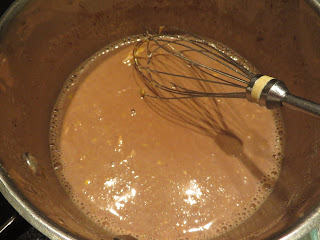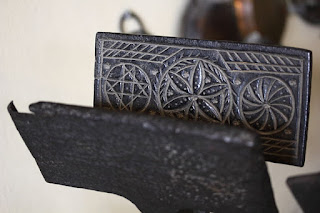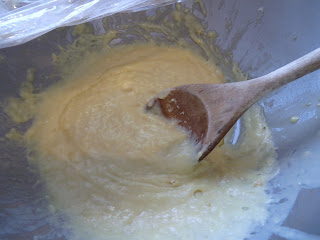Historical Food Fortnightly 2016 Challenge 3:
History Detective
The Challenge: Sweets to the Sweet
It’s sugar, and maybe spice, and definitely everything nice. Test out a historic recipe for sweets, sweetmeats and candies - but don’t let them spoil your appetite!
It’s sugar, and maybe spice, and definitely everything nice. Test out a historic recipe for sweets, sweetmeats and candies - but don’t let them spoil your appetite!
The Recipe: Chocolate Biscuits and bonus challenge: Chocolate Cream
The date, year and region : 18th century England
Chocolate was introduced to Europe in 1502 when Christopher Columbus wrote about cocoa beans during his second voyage. In 1519 Hernán Cortés wrote about the Aztecs drinking chocolate and using it for currency. He brought cocoa beans and chocolate drink-making equipment back to Spain. Wealthy Spaniards enjoyed sipping hot chocolate sweetened with sugar and cinnamon. In 1615, the daughter of Spanish King Philip III wed French King Louis XIII in 1615, she brought her love of chocolate with her to France. The custom of drinking chocolate spread across Europe and reached England in the 1650s and was popular in the court of Charles II. Europeans cacao plantations spread and chocolate houses, where nmen could go to socialize, eat and drink the special chocolate drink. Chocolate houses sold a pressed cake of chocolate for making the drink at home.
Sources: History Channel. The Sweet History of Chocolate.
Cadbury. Discovering Chocolate.
The earliest recipe for chocolate cookies or biscuits as they were called, appears in John Nott's The cooks and confectioners dictionary in 1733.
I found several historic recipes for a chocolate meringue cookie and many for chocolate cream dating back to the Elizabethan era. Fellow Challenger Joyce White researched the history of chocolate biscuits, which you can read on her blog A Taste of History. Carolina from Historic Cookery also has an excellent history.
Frederick
John Farley. The London Art of Cookery and Domestic Housekeeper's Complete Assistant (1811).
 |
| Chocolate Biscuits Batch 2 |
The date, year and region : 18th century England
Chocolate was introduced to Europe in 1502 when Christopher Columbus wrote about cocoa beans during his second voyage. In 1519 Hernán Cortés wrote about the Aztecs drinking chocolate and using it for currency. He brought cocoa beans and chocolate drink-making equipment back to Spain. Wealthy Spaniards enjoyed sipping hot chocolate sweetened with sugar and cinnamon. In 1615, the daughter of Spanish King Philip III wed French King Louis XIII in 1615, she brought her love of chocolate with her to France. The custom of drinking chocolate spread across Europe and reached England in the 1650s and was popular in the court of Charles II. Europeans cacao plantations spread and chocolate houses, where nmen could go to socialize, eat and drink the special chocolate drink. Chocolate houses sold a pressed cake of chocolate for making the drink at home.
Sources: History Channel. The Sweet History of Chocolate.
Cadbury. Discovering Chocolate.
I found several historic recipes for a chocolate meringue cookie and many for chocolate cream dating back to the Elizabethan era. Fellow Challenger Joyce White researched the history of chocolate biscuits, which you can read on her blog A Taste of History. Carolina from Historic Cookery also has an excellent history.
Scrape a little Chocolate upon the Whites of Eggs, so much as
will give it the Taste and Colour of the Chocolate. Then mingle with it powder
Sugar, till it becomes a pliable Paste. Then dress your Biskets upon Sheets of
Paper in what Form you please and set them into the Oven to be bak'd with a
gentle Fire both at top and underneath.
John Nott. The cooks and confectioners dictionary; or, The accomplish'd housewifes companion (1733)
Chocolate Biscuits-
No 18 CHOCOLATE BISCUITS Take a quarter of a pound of
chocolate and put it on a tin over a stove to make it warm, then put a pound of
powdered sugar in a bason and when the chocolate is quite warm and soft put it
in with the sugar and mix it well with about eight whites of eggs. If you find
it too thin mix more powdered sugar with it just to bring it to a paste so that
you can roll it in lumps as big as walnuts. Let your oven be moderate, put three
papers under them. Let the oven just raise them and make them crisp and firm, let
them be quite cold before you take them off the paper.
Chocolate Puffs-
Chocolate Puffs. Having beat and sifted half a pound of
double refined sugar scrape into it an ounce of chocolate very fine and mix
them together. Beat the white of an egg to a very high froth and strew in the
sugar and chocolate. Keep beating it till it is as stiff as a paste. Then sugar
the paper drop them on the size of a sixpence and bake them in a very slow oven.
Another old recipe and a modern adaptation can be found at Baking History.
From the original recipe by Amelia Sulzbacher in: “The Good Housekeeping Woman’s Home Cook Book”, c1909—USA
Bonus:
Chocolate Cream
Chocolate Cream or egg cream is a type of custard dessert that dates back to Elizabethan times. It uses up the egg yolks left over from the chocolate biscuits.
Elizabethan Chocolate Cream
Elizabethan Chocolate Cream
Take a Quart of cream, 3 ounces of Chocolate grated, boyle it well together & let it stand till tis cold, & then put in ye whites of 6 Eggs beaten to a froth & sweeten it to your Taste, and then mill it up.
The Complete Receipt Book of Ladie Elynor Fetiplace. Vol. Three. Transcription. Stuart Press: 1999. p.38.
I found this version on the next page after the Chocolate Biscuits recipe in John Nott's cookbook.
Chocolate Cream
How did you make it:
I used modern adaptations as a guideline for oven temperature and consistency but pretty much followed the original recipes.
I preheated the oven to 300 degrees Fahrenheit.
First, I had to make refined sugar. I ground regular granulated sugar in a blender until soft and powdery.
First, I had to make refined sugar. I ground regular granulated sugar in a blender until soft and powdery.
 |
| superfine sugar |
For the first batch, I used American Heritage Chocolate I picked up in Colonial Williamsburg years ago. It is bittersweet chocolate with added spices to mimic the taste of 18th century chocolate that had been ground in a mortar and pestle.
I grated the chocolate into a bowl and melted it a bit over a double boiler.
Then I followed the directions! I put my melted chocolate into the bowl of a modern stand mixer and added the sugar.
Next I separated my eggs and whipped the whites with an electric hand mixer until fluffy.
I added a tablespoon of egg whites into the chocolate mixture and blended it with the mixer on low speed. I added about 4-5 tablespoons of egg whites before my mix became too runny.
I added too much egg white. I tried to add more sugar to stiffen it up a bit but that only made the mixture too gritty and sweet. I quickly dropped the soupy batter on a baking sheet lined with parchment paper and baked for about 15 minutes.
I tried again with Mexican chocolate which has sugar added. I reduced the amount of sugar added less egg whites until my mixture was a soft paste. I scraped some into my hands and rolled into a walnut sized ball. I rolled that into sugar, placed on a parchment lined cookie sheet and flattened with my hands.
I baked at 300 degrees for about 15-20 minutes. I let cool a bit on the cookie sheet before transferring to a wire rack.
 |
| The last of my Heritage Chocolate |
I grated the chocolate into a bowl and melted it a bit over a double boiler.
Then I followed the directions! I put my melted chocolate into the bowl of a modern stand mixer and added the sugar.
 |
| Chocolate added to sugar |
Next I separated my eggs and whipped the whites with an electric hand mixer until fluffy.
 |
| fuffy egg whites |
I added too much egg white. I tried to add more sugar to stiffen it up a bit but that only made the mixture too gritty and sweet. I quickly dropped the soupy batter on a baking sheet lined with parchment paper and baked for about 15 minutes.
I tried again with Mexican chocolate which has sugar added. I reduced the amount of sugar added less egg whites until my mixture was a soft paste. I scraped some into my hands and rolled into a walnut sized ball. I rolled that into sugar, placed on a parchment lined cookie sheet and flattened with my hands.
 |
| Unbaked cookies |
Bonus challenge:
I had leftover egg yolk with bits of grated chocolate mixed in so I tried to make egg cream.
I had leftover egg yolk with bits of grated chocolate mixed in so I tried to make egg cream.
I warmed whole milk on the stove with sugar and a cinnamon stick until boiling. I then added 3 squares of Mexican chocolate and stirred until mixed and added a dash of real cassia cinnamon. Next I added the egg yolks and whisked.
My milk/chocolate mixture was too hot and the egg yolks turned to scrambled egg. Yuck!
Since the original directions say to pour through a sieve, that's what I did. I poured the mixture through a strainer and into a mug. It made tasty hot chocolate.
My milk/chocolate mixture was too hot and the egg yolks turned to scrambled egg. Yuck!
 |
| Chocolate Cream meets scrambled eggs? |
Since the original directions say to pour through a sieve, that's what I did. I poured the mixture through a strainer and into a mug. It made tasty hot chocolate.
How Successful Was It?:
Contrary to what the adapted recipe says, the chocolate biscuit recipe did NOT fail! The cookies actually came out light and puffy with a glossy top. They crumbled when I took them off the baking sheet though. They taste good anyway - a cross between a cookie and a candy.
The second batch was successful in so far as making a paste I could work with my hands but they didn't bake up as pretty. They taste really good - less sweet than the first batch and less crumbly.
The egg cream was not successful.
The second batch was successful in so far as making a paste I could work with my hands but they didn't bake up as pretty. They taste really good - less sweet than the first batch and less crumbly.
The egg cream was not successful.
Time to Complete: Not too long after I made the sugar. About an hour or so.
Total Cost: I had all ingredients on hand.






















